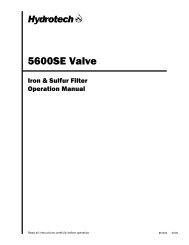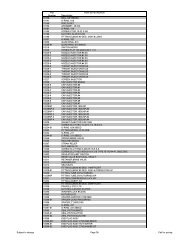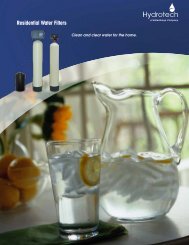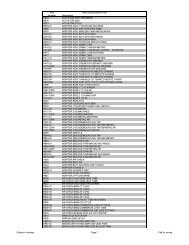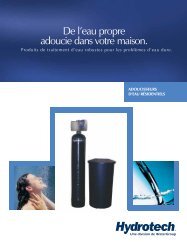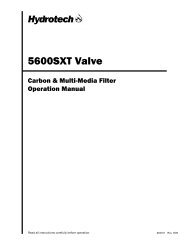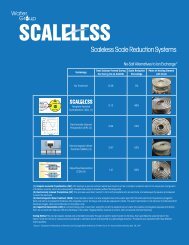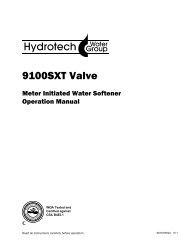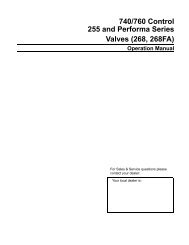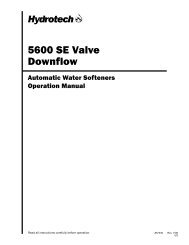HY US 01 Introduction.qxp - Hydrotech
HY US 01 Introduction.qxp - Hydrotech
HY US 01 Introduction.qxp - Hydrotech
Create successful ePaper yourself
Turn your PDF publications into a flip-book with our unique Google optimized e-Paper software.
Disinfection - A process in which pathogenic, disease<br />
producing bacteria are killed. May involve disinfecting<br />
agents such as chlorine or physical processes such as<br />
heating.<br />
Dissolved Solids - The weight of matter in true solution<br />
in a stated volume of water. Includes both inorganic and<br />
organic matter and is usually determined by weighing the<br />
residue after evaporation of the water at 105°F or 180°C.<br />
Distillation - The process in which a liquid, such as<br />
water, is converted into its vapor state by heating and the<br />
vapor cooled and condensed to the liquid state and<br />
collected. Used to remove solids and other impurities<br />
from water. Multiple distillations are required for extreme<br />
purity.<br />
DNA - Deoxyribonucleic acid constituting the genetic<br />
material of the chromosome in a cell, responsible for<br />
reproductive characteristics.<br />
Drawdown - The amount of water delivered by the<br />
storage tank between pump shut-down and pump start.<br />
E-Coli (Escherichia Coli) - One of the members of the<br />
coliform group of bacteria indicating fecal contamination.<br />
Effluent - The stream emerging from a unit, system or<br />
process such as the softened water from an ion<br />
exchange softener.<br />
Exhaustion - The state of an ion exchange material in<br />
which it is no longer capable of effective function due to<br />
the depletion of the initial supply of exchangeable ions.<br />
The exhaustion point may be defined in terms of a<br />
limiting concentration of matter in the effluent or, in the<br />
case of demineralization, in terms of electrical<br />
conductivity.<br />
Fecal - Matter containing or derived from animal or<br />
human waste.<br />
Feed Pressure - The pressure at which water is<br />
supplied to the R.O. module.<br />
Feed Water - A term which refers to the water supply<br />
that is put into a water treatment system for processing<br />
(removal of impurities.)<br />
Flocculation - The agglomeration of finely divided<br />
suspended solids into larger, usually gelatinous,<br />
particles. The development of a ‘floc’ after treatment with<br />
a coagulant by gentle stirring or mixing.<br />
Flow Control - A device designed to limit the flow of<br />
water or regenerant to a predetermined value over a<br />
broad range of inlet water pressures.<br />
Flow Rate - The quantity of water or regenerant which<br />
passes a given point in a specified unit of time, often<br />
expressed in gallons per minute.<br />
Flux - The flow rate of water through reverse osmosis<br />
membranes, per square foot of surface.<br />
Fouling - The process in which undesirable foreign<br />
matter accumulates in a bed of filter media or ion<br />
exchanger, clogging pores and coating surfaces and thus<br />
inhibiting or retarding the proper operation of the bed.<br />
Freeboard - The vertical distance between a bed of filter<br />
media or ion exchange material and the overflow or<br />
collector for backwash water. The height above the bed<br />
of granular media available for bed expansion during<br />
backwashing. May be expressed either as a linear<br />
distance or a percentage of bed depth.<br />
Grain (gr) - A unit of weight equal to 1/7000 of a pound<br />
or 0.0648 gram.<br />
Grain per Gallon (gpg) - A common basis for reporting<br />
water analysis in the United States and Canada. One<br />
grain per U.S. gallon equals 17.12 milligrams per liter<br />
(mg/l) or parts per million (ppm). One grain per British<br />
(Imperial) gallon equals 14.3 mg/l or ppm.<br />
Greensand - A natural mineral, primarily composed of<br />
complex silicates, which can be coated with manganese<br />
oxide to form a catalytic absorptive surface. This surface<br />
is used to attract ferrous iron and manganese as well as<br />
to absorb dissolved oxygen which is used to oxidize iron,<br />
manganese or hydrogen sulfide.<br />
Hardness - A characteristic of natural water due to the<br />
presence of dissolved calcium and magnesium. Water<br />
hardness is responsible for most scale formation in pipes<br />
and water heaters and forms insoluble “curd” when it<br />
reacts with soaps. Hardness is usually expressed in<br />
grains per gallon (gpg), parts per million (ppm) or<br />
milligrams per liter (mg/l), all as calcium carbonate<br />
equivalent.<br />
Hard Water - Water with a total hardness of 1 gpg or<br />
more as calcium carbonate equivalent.<br />
Hydrologic Cycle - The natural water cycle, including<br />
precipitation of water from the atmosphere as rain or<br />
snow, flow of water over or through the earth and<br />
evaporation or transpiration to water vapor in the<br />
atmosphere.<br />
Hydrogen Sulfide (H2S) - A gas characterized by an<br />
offensive odor, commonly referred to as “rotten egg”<br />
odor. Flammable and poisonous in high concentrations,<br />
corrosive to most metals and can even tarnish silver.<br />
308 <strong>Hydrotech</strong>



